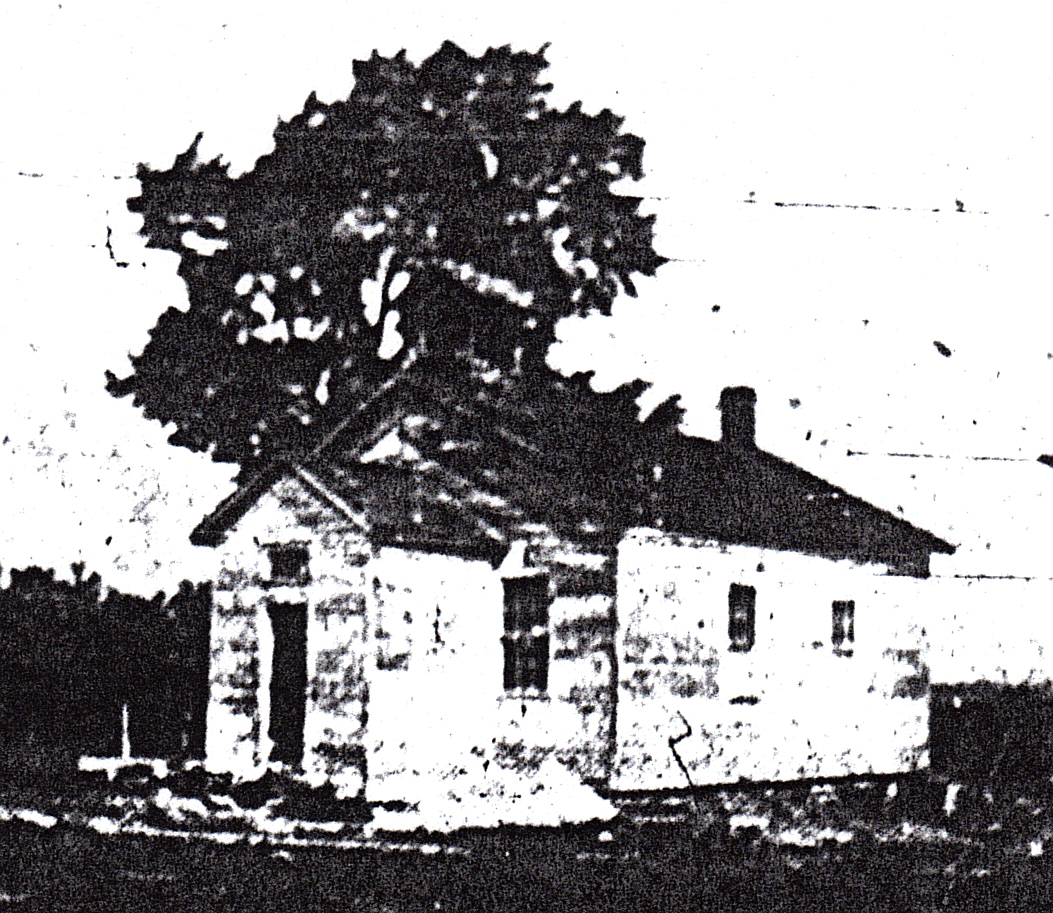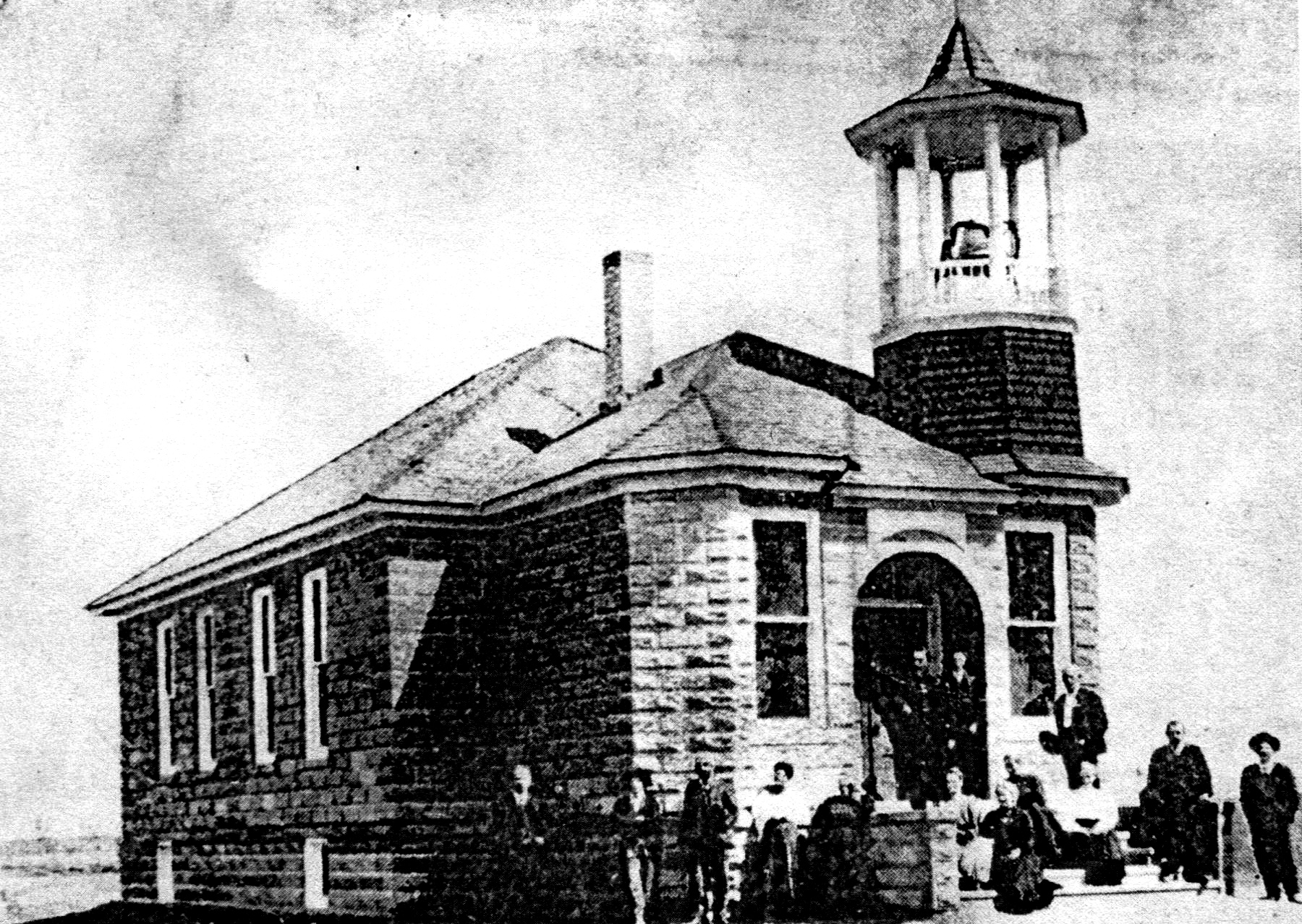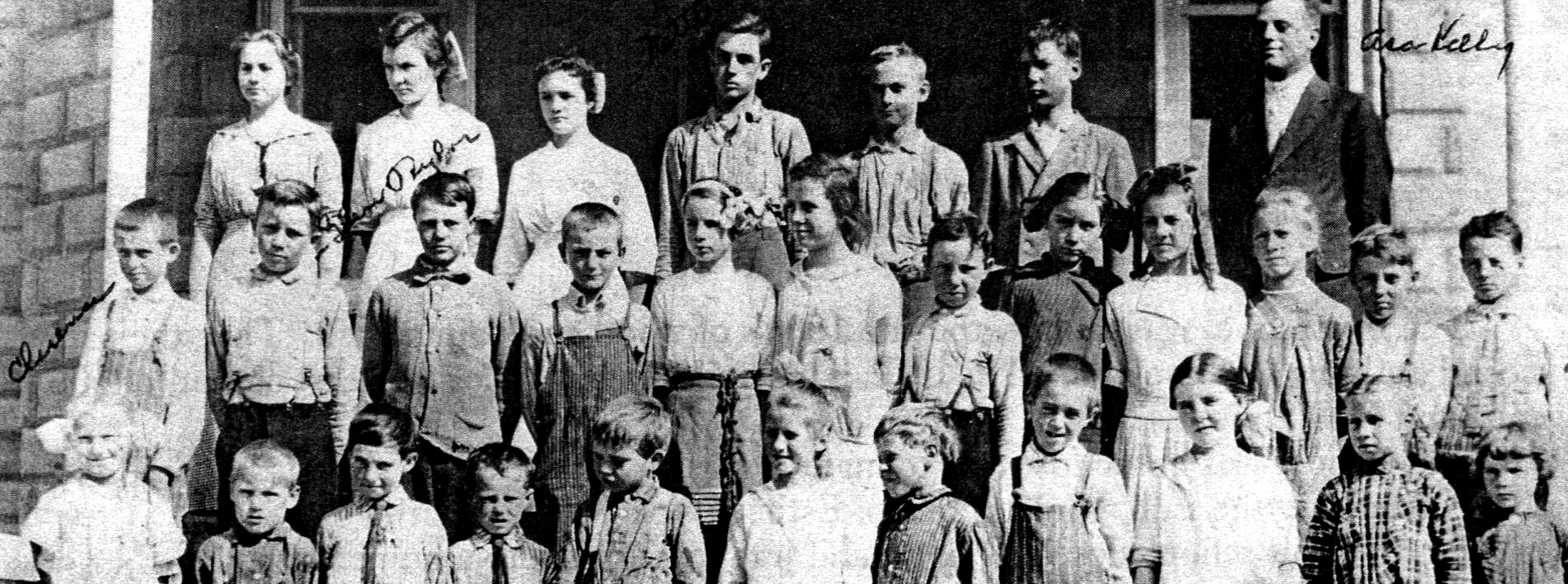



Photos of the Old Wooden Marshall School and the later block building

Students of Marshall School, Unknown Year
Marshall School District #5 In 1851 Marshall School classes were held in
a lean-to building off the F. A. Marshall home. A wood frame building was
erected in 1855 near Cleveland and 72nd Avenue at a cost of $440. In 1906
a cement block building was constructed to replace the frame one. This
burned and a second cement block building was erected which was much like the
first one and still stands today. The first teacher, Mary Ann Murphy, earned
$2.00 per week, and out of that salary she paid $1.00 a week for room and board
to the family where she stayed. many of the teachers lived with a family
in the area due to poor transportation. Marshall School joined the Coopersville
Public Schools in 1960.
************************************************************************************************* Interesting History of Marshall School Read at First Annual Reunion of Teachers and
Scholars The following history of the Marshall School, was
written by Mrs. George Marshall, and read, by her, at the First Annual Marshall
School Reunion, which was held Friday, August 20: To the Former Teachers, Pupils, and Friends of the
Marshall School, Greetings: For many years, I, the Spirit of the Marshall School,
have been longing and hoping for this reunion, for there were so many things I
wanted to tell you which I fear you have forgotten. The Marshall school was organized September 6, 1851.
The members of the Board were H. C. Durphy, Joel Parish and Timothy Collins. The
school was held in a little lean-to off of F. A. Marshall's house until the
spring of '55 when a building was erected at a cost of $440. F. A. Marshall was
the contractor. The Building Committee were Henry Lawton, N. D. Wood and Enos
Parish. The first teacher, hired in 1851, was Mary Ann Durphy,
and she was paid the magnificent salary of two dollars a week, (Teachers please
take notice), and she boarded at F. A. Marshall's paying one dollar a week
board. Her contract was some different than the contracts of today; School every
day except every alternate Saturday, Sunday and the Fourth of July. I often
contrast the good old days and the 0present, but in no instance do I find
greater contrast than in the prices of 1851 and 1920. Why, wood was furnished
for the school by F. A. Marshall for sixty cents a cord. I was trying to count up the teachers the other day,
and I find just fifty-three. Among these, twenty have gone to the great beyond.
You might be interested, if I tell you the names of all these teachers: As I name these teachers, recollections crowd thick
and fast, especially back in the early dyas. I am so glad so many of the early
pupils are here today, and that they survived so many serious school accidents.
I'll never forget when Charlie Lawton cut the end of his finger off and sprained
his knee, so that he couldn't run fast; George Marshall broke his arm and Fred
Marshall his nose; but one boy never had an accident, never got his clothes
dirty, in fact, Ed Durphy was the model and exemplary boy of the school. You
never found him up to tricks like Phil Turner, Ben Sharratts, John Sharratts,
Wells Parish and Dell Durphy and many others I could name. William Philleo, the oldest teacher living had all
these unruly boys for pupils, and no doubt he can tell you many tales out of
school. He is now residing near Kalamazoo. You have another old teacher living, William Barrett.
He is living with his daughter Grace, in Grand ?Rapids, and though he has almost
lost his sight, he is bright and cheerful and dearly loved to talk over old
times. You will notice that another old teacher, Lillie
Blakeney Howe is on the program today for a song, and though a number of years
have elapsed since she taught the Marshall school, we are glad she is still
giving us the pleasure of hearing her voice in song. Emma Brace, you observer there is no other name
attached to hers, is keeping house for her brother instead of some one else's
brother. Thomas Culligan is working in the interests of a big
corporation, the Grand Rapids Railway Co., and Vina Bailard Busman married a
doctor, and is living in Chicago. And just think of the teachers from the City of
Dennison: T. G. McGrath, who is in business in Chicago; Minnie Brown; Lizzie
McCarty Golden, who lives in Howard City; Minnie McCarty Zoles and Etta
Fitzpatrick Stevens, who are on farms, also Carrie Bailard. Lillian Cole Murray is living in Coopersville and
seems to have found Ponce de Leon's secret--never growing old. Now, would you have thought that when Chet Richards
was teaching, that "politics" was his highest aspiration? Well, it is, and he
never expects to give up until he writhes "Governor" before his name. Now maybe you don't know it, but Mary Nixon Holmes
taught the longest of any one at the Marshall school. Why, for about five years
she labored to impart knowledge to those youngsters and she did it too, because
you see they all loved her. Nearly always we have to go away to receive honor
but her own home district honored and loved her. History of Marshall School The Marshall School district was organized September
6, 1851 at a meeting of the taxpayers at the home of Henry Durphy, who lived on
what is now the Herbert Laug farm. At this meeting they elected the following
members for a district board: Henry Durphy, Joel Parish and Timothy Collins. The
first school was held in a little lean-to off the F. A. Marshall home. The first
teacher was Mary Ann Murphy, who was paid $2.00 a week and out of this she paid
$1.00 a week for her board. She taught school every day except every other
Sturday, Sundays and July 4th. In the spring of 1855 a meeting was called again
at the home of Henry Durphy to discuss plans for building a school house. It was
decided to build a school at a cost of $440.00. A building committee was chosen,
namely; Henry Lawton, N. D. Wood and Enos Parish. The building was to be built
on the southwest corner of Section 15, which at that time was covered by woods.
A contract was let to F. A. Marshall for the sum of $9.00 to clear the land. The
plans for the new building were submitted by the Committee to the residents of
the district and were accepted. The specifications for the building were: The
building was to be 24 x 30 feet. The sills were to be white oak and the floor
white ash. There were to be two windows on each side and two on each end with 12
lights in each window and the glass to be 9 x 13 inches. There was to be an
entry way to the whole length at one end of the building. There were to be two
4-panelled doors with a lock and key attached to the outside door. The inside of
the building was to be sealed up to the bottom of the windows and above that
ceiling was to be lathed and plastered. On each side of a door a hard finish was
to be put on the wall and painted black for a blackboard; also one behind the
teachers desk. Two rows of hand-made seats and desks were installed. The outside
of the building was to be covered with good pine siding and the roof covered
with the best pine shingles and the building was to be given two coats of paint.
A chimney was to be built and a large box stove installed in the middle of the
room. A contract was let to Jacob Sharrots to furnish 15 cords of 20ft. wood at
$1.25 per cord. In 1857 they began to find ways to raise more money to
pay the expenses of running the school, so they assessed each pupil $1.00. That
paid the teacher, the wood and that year they bought a Webster's dictionary. Tis history could go on and on. You may wonder where
all this information came from. There is a record book which is 100 years old
and in it are the records of all the school meetings down to almost the present
time. Not many years after the school started, a Mr. Gregg used to come to the
school on evenings to teach penmanship, and I must say that they were better
writers then, than now; at that time they were taught on reading, writing and
arithmetic. Around 1880 a school library was founded and in it
were books on fiction and travel. In 1890 a singing school was started, with Mr.
George Laubach as instructor and the evenings were enjoyed by old and young. In 1906 it was decided by the voters that a new school
was needed. It was built of cement blocks, and the first teacher was Mrs. Carrie
Baillard Thorpe. In 1914 this building burned, when Laura Hosmer Locklin was
teaching. The school was rebuilt and is the present building. It is impossible to mention all of the families who
lived in the district about 1851. But there were the Walter's the Durphy's, F.
E. Easton, Harter, Sharrett, Austin, DeCan, Peabody, Nixon, Gates, Collins,
Aikers, McClellan, Dimock, Smith, Parish, Jewell, Stamp, and probably many more.
After 1878 there were the Callahan's, Fox, Taylor, Stapleton, Michael, Swifink,
Parkins, Connell, Jordan, Laug's, Blackmer, Swartz, Turner, Beers, Woodhull,
Seymour, Bliss, Burgomaster, Hancock, Haystead, Kelly, Wallis, Walbring,
Hecksels, Bushman, Christian, Laufersky, Walt, Venema, and Walcott. In ??1837?? Mr. Ezekiel Jewell was elected director
and he held that office until 1897, when the late George Marshall became
director. He was followed by Edwin Nixon, Henry Marshall, Mrs. Henry Marshall,
Mr. John W. Laug, and now Harold Veeneman. As to the teachers there have been
many during this time. I only know of two of the older teachers still living and
they are Mrs. Mary (Nixon) Holmes of Coopersville, and Mrs. Lizzie (McCarthy)
Golden of Howard City. I am very happy to say I went to school to both of them.
At the time they were teaching, the last day of school came in August. For a
month we practiced songs, dialogues, and recitations, and when the day came the
men of the district would build a stage in the Newton woods (which is now the
Swartz farm); someone in the district would loan an organ for our program.
Everyone in the district would be there for the dinner at noon and in the
afternoon would be the program. In 1920 a Marshall school reunion was held in Harm
Laug's woods. There were about 340 former teachers and pupils present. This
would be a good place to mention some of the teachers who taught here and I am
sure many of them you will remember. There was Thomas Culligan, Lizzie McCarthy,
Minnie Zolls, Lillian Cole Murray, Thomas McGrath, John Powers, Chester
Richards, Mary Nixon Holmes, May Dimmock Comstock, Belle McLellan Weatherwax,
Edith Woodman, Henry Marshall, John Schaub, Carrie Baillard Thorpe, Thomas
VandenBosch, Harry Easton, Mary Easton, Celia Ginsburg, Diana Bailard Bushman,
Avis Parish VanEeuwen, Lura Hosmer Locklin, Asa Kelly, Florence Westover
Gilmore, Philo Way, Sadie Hart Lillis, Mary Stevens Kendall, Ruth Hubbel Parish,
Marjorie Frost Messinger, Mrs. Hester Ruster, Mrs. Robert Turner, Mrs. Ruth
Ellis, Edna Housler Wohlford, Constance Hillman Frank, Mrs. Inez Hubbel and at
present Mrs. LaVerne Sichterman. In 1926 a Parent-Teachers Association was
organized and active until 1937. Of late a Mother's Club was formed and has been
very active and are the sponsors of tonight's program. In 1890 the school was made an 8th grade school and
pupils who passed the 8th grade could then go to Coopersville High School which
at that time was an 11th grade school. Every year since then as the pupils left
the Marshall school there have been those who became teachers, musicians,
nurses, clerical workers, farmers, lawyers, ministers and others. We are proud
of the talent we still have with us and in the school. The oldest living pupil of the Marshall school is my
aunt, Mrs. Susan Lawton Smith of Belding, who was 93 last month. This is the
only school that she ever attended. She later studied music and taught in this
vicinity. Four generations of my own family have attended the
Marshall school, my father, F. W. Turner, myself, my children and all of my
grandsons. Young men of the Marshall school district answered
their country's call at the time of the Civil War, World War I and II, and some
now in the Korean conflict. The youngsters who are now attending the school and
are with us tonight will continue to uphold the tradition and honor of the
school, I am sure. There will be many more stories and names to write in the
next 100 years of the school's history.
Mary Ann Durphy, F. A. Marshall, Etta Cook, Emily Tracy, Amelia Lewis, Alice
Hazelton Taft, Amelia Blackman, Henrietta McDerman, William Philleo, Maggie
Chappel, Mattie Cady Wright, Reuben J. Foster, Lucy Sterling, Emily S. Walter
Stamp, William T. Stamp, Mary G. Enos, William R. Barrett, Lillie Blakeney Howe,
Jennie Woodmen Ayers, Emma Brace, Addie Wright, W. A. Norcross, Josephine Bishop
Holden, Warren Wright, Mary Cunningham Starling, Thomas Culligan, Minnie McCarty
Zoles, Etta Wellman, Vina Bailard Busman, Lillian Cole Murray, T. G. McGrath,
John Powers, Etta Fitzpatrick Stevens, Minnie Golden Brown, Lizzie McCarty
Golden, Chester Richards, Mary Nixon Holmes, May Dimock Constrock, Belle
McClellan Weatherwax, Edith Woodman Yarrington, Henry Marshall, J. A. Schaub,
Carrie Bailard, Thomas C. VandenBosch, Harry Easton, Mary Easton, Avis Parish
VanEeuwen, Lura Hosmer Locklin, Asa Kelly, Florence Westover Stevens, Philo Way,
Sadie Hart Lillis, Mary Stevens.
by Mrs. Albert J. Omlor
Scanned: ES Transcriber: ES
Created: 4 October 2009 and 20 April 2012